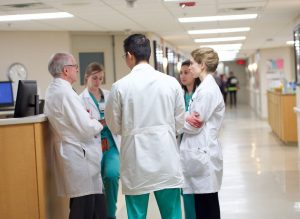In a little less than a month, we will kick off the final season of the academic year with Match Day. This represents a meaningful turning point when we start readying our farewells and finalizing plans for the year ahead. We learn where our medical students are headed, how many will be staying at Iowa for residency, and most important, who will be joining us in June for our residency. For me, one of the most personal transitions is the handoff from one set of Chief Residents to the next. My Thursday morning Chair’s Rounds with the Chiefs is one of my most cherished appointments. Spending time at the bedside with our trainees, students, and residents represents an essential element of training the next generation of physicians. It reinforces the truism that listening carefully to what our patients tell us and how their physical findings direct us remains the bedrock of clinical medicine, even in an era of advanced imaging and diagnostics.

Moreover, learning medicine at the bedside models how to build rapport with our patients and how to communicate in ways that supports their recovery. I use this opportunity and this soap box to encourage us to not depend on the EMR as a primary or sole source of information, but to get as much relevant information and perspectives from the bedside. To this end, the department is committed to supporting a cadre of master clinicians who will work with our students and trainees to model the best of what clinical medicine should be. The bedside will always be the most important location for any physician, the location of our most direct impact, where all our years of training and research collapse into one set of circumstances where we must perform at our best. I am always impressed as I watch the already-keen clinical minds of our Chiefs grow sharper over the year and their facility with instruction of others make a real difference for their learners. As I watch quartet after quartet of Chief Residents ensure that the trainees who leave the University of Iowa (or remain in new roles!) are not just filled with head knowledge, but also the skills to apply that knowledge with empathy at the bedside, I believe that our mission is being achieved.
In addition to being the focus of care, the bedside also represents one of our most powerful opportunities for learning, research, and scholarship. The opportunity to conduct rigorous clinical investigation represents an important differentiator between our academic medical center and a non-teaching hospital. However, conducting effective clinical and translational research does not happen in a vacuum and requires training and effective infrastructure. Important regulatory requirements, rigorous study design, and statistical considerations seem daunting and, for some, impenetrable. As I reflected on this topic, I became aware that many of our faculty, although interested in clinical research, are not fully aware of all the resources that are available in our Institute for Clinical and Translational Science (ICTS) and the Clinical Research Unit (CRU) housed within it, which exist to support and enhance clinical investigation at the University of Iowa. Although the ICTS and CRU are currently working on deploying additional outreach efforts both for investigators as well as clinical trial participants, I am happy to help spread the word here about the resources available to support your clinical research studies. Many of our Internal Medicine faculty are in leadership roles within both organizations, including Executive Dean Dr. Pat Winokur, Dr. Alejandro Comellas, and Dr. Heather Reisinger. Many of our faculty have taken advantage of the many resources for diverse clinical and translational projects, from short-term studies to longer, sometimes multi-year, clinical trials with multiple follow-up visits. The ICTS and CRU can help investigators at any stage in a project. Kim Sprenger, the Clinical Research Manager and recent winner of the university’s award for staff excellence, is quick to advise “the earlier the better.” As more of our junior faculty express interest in clinical research, it is timely that our organization increases its focus on expanding our institution’s research base—already strong in basic science—to increase our ability to bring our quest for knowledge to the bedside. The ICTS and CRU have a full complement of multidisciplinary experts ready to help guide you through an IRB or a study design or to help recruit and retain your trial participants. Explore all the ways the ICTS can help your research. That said, the department wants to know of any barriers or concerns that you perceive or have, so that we can work collaboratively to move our capabilities in clinical research forward.
One specific area in which the ICTS can help guide researchers is in quantitative studies, harnessing the power of “big data” to better understand which courses of treatment are effective or what pitfalls may lie ahead. One of our junior faculty, Dr. Amgad Mentias, until recently a Chief Fellow in our cardiovascular medicine fellowship, recently made important observations using large datasets. The first, covered here in the New York Times, reveals the important role that revascularization has played in reducing the number of amputations in veterans. Kudos to Dr. Mentias and to Drs. Saket Girotra and Mary Vaughan Sarrazin on this work and for the widespread media coverage that this received. Dr. Vaughan Sarrazin also worked with Dr. Mentias on another big-data discovery and publication, which should help guide post-op surveillance of TAVR patients.

